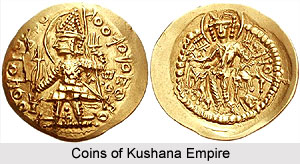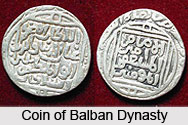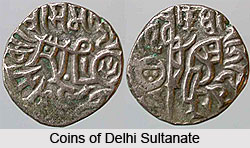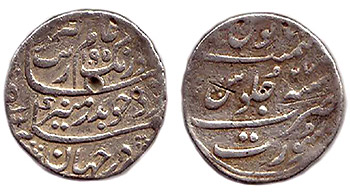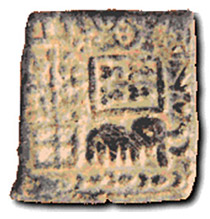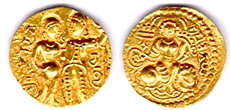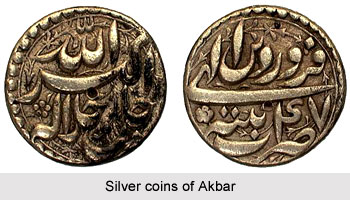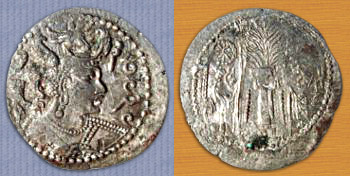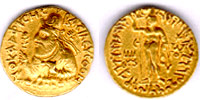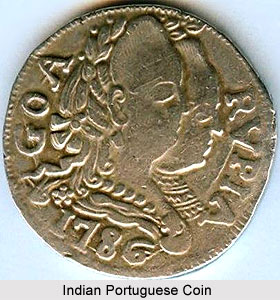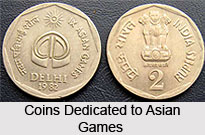 New coins were issued in independent India in 1950. The coins followed the earlier Indo-English coins in respect of their value, weight, metal and fabric. Gradually the designs and patterns of the coins changed significantly to eliminate the vestiges of foreign domination. The new designs were introduced which incorporated the symbols representing India`s past glory and the hopes and aspirations for the future. Thus, these coins can easily be considered the first stepping stone to the contemporary coinage system in India.
New coins were issued in independent India in 1950. The coins followed the earlier Indo-English coins in respect of their value, weight, metal and fabric. Gradually the designs and patterns of the coins changed significantly to eliminate the vestiges of foreign domination. The new designs were introduced which incorporated the symbols representing India`s past glory and the hopes and aspirations for the future. Thus, these coins can easily be considered the first stepping stone to the contemporary coinage system in India.
The coins of independent India included image of the Lion Capital of Asoka`s Pillar at Sarnath, the symbol of non violence and peace, which the Indian republic had adopted as its insignia. The superscription `Government of India` took the place of the name of the king. On the reverse side of the coins of rupee, half rupee and quarter rupee denominations, a new motif, a pair of ears of wheat, was placed on the two sides of the English numerals showing the value of the coin. The coins also bore the value in Hindi and below in English and the date below. The rupee coins were security-edged, whereas the half rupee and quarter rupee coins had a milled edge. The reverse sides of two annas, one anna and half anna were embellished with the figure of a bull, adapted from the base of the Lion Capital. The reverse side of the pice coin of this time contained the figure of horse. The rupee, half rupee and quarter rupee were made in pure nickel, the two annas, one anna and half anna were made in cupro-nickel and the pice was made of bronze.
The metric or decimal system was introduced in 1957 in India. Under the new system, the Rupee retained its original value but instead of being divided into 64 pice, it was divided into 100 units that were termed as `Paisa` and it became the primary unit of Indian currency. Even today the same system is followed by the contemporary coins in India.
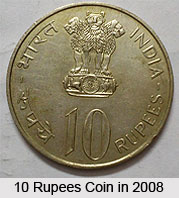 With the introduction of the metric coinage, the earlier familiar equivalents of half rupee and quarter rupee were retained in their original round shape and in pure nickel with the new designations 50 paise and 25 paise respectively. During this time, new denominational coins of 10, 5 and 2 paisa were introduced in cupro-nickel and one paisa in bronze. The modified coins of independent India bore the word `India` in English and `Bharat` in Hindi on the right and left of the Asokan pillar-capital respectively, replacing the Government of India. The reverse side of the coin was designed as the obverse side with a slight change of the word `rupaya` instead of `ek rupaya` in Hindi and the ears of wheat was replaced by the ears of corn. Now the value in English numerals was placed in the centre in bold letters and the denominations were mentioned in two forms.
With the introduction of the metric coinage, the earlier familiar equivalents of half rupee and quarter rupee were retained in their original round shape and in pure nickel with the new designations 50 paise and 25 paise respectively. During this time, new denominational coins of 10, 5 and 2 paisa were introduced in cupro-nickel and one paisa in bronze. The modified coins of independent India bore the word `India` in English and `Bharat` in Hindi on the right and left of the Asokan pillar-capital respectively, replacing the Government of India. The reverse side of the coin was designed as the obverse side with a slight change of the word `rupaya` instead of `ek rupaya` in Hindi and the ears of wheat was replaced by the ears of corn. Now the value in English numerals was placed in the centre in bold letters and the denominations were mentioned in two forms.
Later in 1964, a new coin in aluminium-magnesium alloy of the denomination of three paise was introduced in hexagonal shape. With the suspension of the coin of 25 paise, another coin of twenty paise was introduced in aluminiam bronze in April 1968.again in 1972, the 20 paise coin was dropped and the minting of 25 paise coin was resumed. These coins were issued in cupro-nickel instead of pure nickel. The new denominations of the coins were of rupee, 50 paise, 25 paise, 10 paise, 3 paise, 2 paise and 1paise. Afterward, some of the latter denominations were gradually dropped as they lost their monetary utility. The shape of the coins was also changed with the change of metal for the coins in later period. In 1972, cupro-nickel alloy was introduced for the 50 paise coin and its milled edge was changed into security edge and the reverse side of the coin was slightly modified. The fractional relationship of the coin with Rupee was dropped from this and all other coins. Since then the denominations were mentioned only in Paise in Nagari and English.
With the undertaking of Bombay mint in issuing commemorative coins, a new phase was introduced in the history of coins and coinage o the independent India. The initiative was taken by issuing coins of the value of Rupee and 50 paise on 14 the November 1964 in memory of the first Prime Minister of India, Pandit Jawaharlal Nehru. These coins were made of pure nickel and were of identical shape, size and weight as the current coins of same denominations. These coins bore the bare head of Nehru to the left and the name Jawaharlal Nehru above with the date below. The reverse side of the coin was decked with the Asoka pillar-capital emblem on the top and the value in numerals below. The capital was flanked by the word `Bharat` in Hindi on the left and `India` in English on the right. Similarly, the numerals were flanked by the words `Rupiya` and `Paise` respectively on the two coins, on the right and left of the numeral in the two languages.
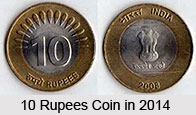
On 2nd October, 1969, the second series of four coins in the denominations of 10 rupees, 1 rupee, 50 paise and 20 paise were issued to commemorate the birth centenary of Mahatma Gandhi. In 1985, a third series of four coins in the denominations of 100 rupees, 20 rupees, 5 rupees and 50 paise were issued on the first death anniversary of Indira Gandhi. The se coins bore the portrait of Indira Gandhi on the obverse side of the coin. Later coins were issued from time to time in memorial of eminent personalities and important dates. On the occasion of the International Children`s Year in 1980, a coin of 100 rupees was issued and the coin contained music and dance scene. In 1982, on the occasion of the Asian Games held at Delhi, a set of five coins of 100, 10, 2 rupees and 25 paise and 10 paise were issued depicting the historic observatory Jantar Mantar at delhi on the obverse side of the coin. A set of three coins of 100 rupees and 10 rupees and 50 paise were issued in 1985, in memorial of the Golden Jubilee of the Reserve Bank of India. Alter on the birth anniversary of Pandit Jawaharlal Nehru, a set of three coins of 100, 5 and 1 rupee were issued with his portrait in 1989.
The second `Development Oriented` set of three coins of the denominations of 50 and 10 rupees and 10 paise were issued on 15 August 1974. These coins bore the slogan of family planning symbolized with triangle. The 50 rupee coin had the quaternary alloy and weighed 35 grammes, while the10 rupees coins weighed 25 grammes. Till 1980, Development Oriented Coins were issued with slogans. Later the slogans were eliminated and the areas of development were emphasized. The coins carried the same metal content with motifs on them relating to the subject in focus.
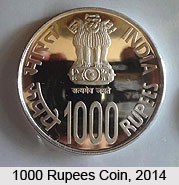 The coins of the contemporary India had undergone several changes and have come to a standard recognition. Moreover, the coins are minted in India. There are four mints in India each with a long and distinguished history. The two oldest are Alipore (Kolkata) and Bombay (Mumbai) mints. Apart from these there are other mints at Hyderabad (Andhra Pradesh) and Noida (Uttar Pradesh). The Noida mint was the first in the country to mint coins of stainless steel. Each mint that issued coins included special characteristics on the coins. The Bombay (Mumbai) mint included a small dot or diamond mint mark under date of the coin, whereas the Calcutta mint had no mint mark beneath the date of coin. The Hyderabad mint, on the other hand, had five pointed star under the date of coin and the Noida mint contained a small or thick dot under the date of the coin.
The coins of the contemporary India had undergone several changes and have come to a standard recognition. Moreover, the coins are minted in India. There are four mints in India each with a long and distinguished history. The two oldest are Alipore (Kolkata) and Bombay (Mumbai) mints. Apart from these there are other mints at Hyderabad (Andhra Pradesh) and Noida (Uttar Pradesh). The Noida mint was the first in the country to mint coins of stainless steel. Each mint that issued coins included special characteristics on the coins. The Bombay (Mumbai) mint included a small dot or diamond mint mark under date of the coin, whereas the Calcutta mint had no mint mark beneath the date of coin. The Hyderabad mint, on the other hand, had five pointed star under the date of coin and the Noida mint contained a small or thick dot under the date of the coin.
Later with the support from the Government of India, the Reserve Bank of India started issuing coins and since then and the coins are issued for circulation only through the Reserve Bank according to the RBI Act.
